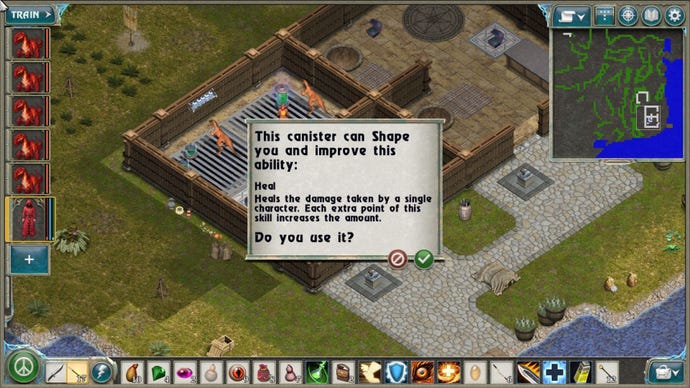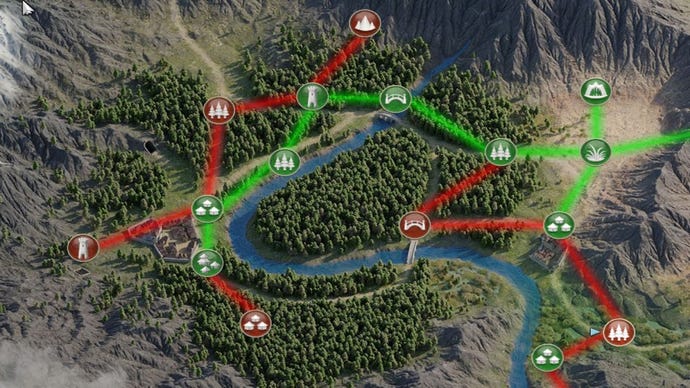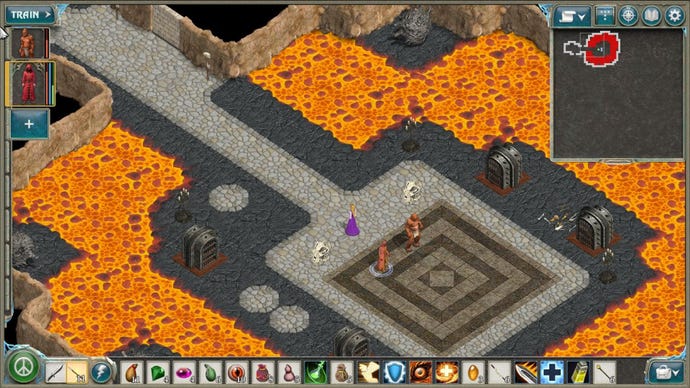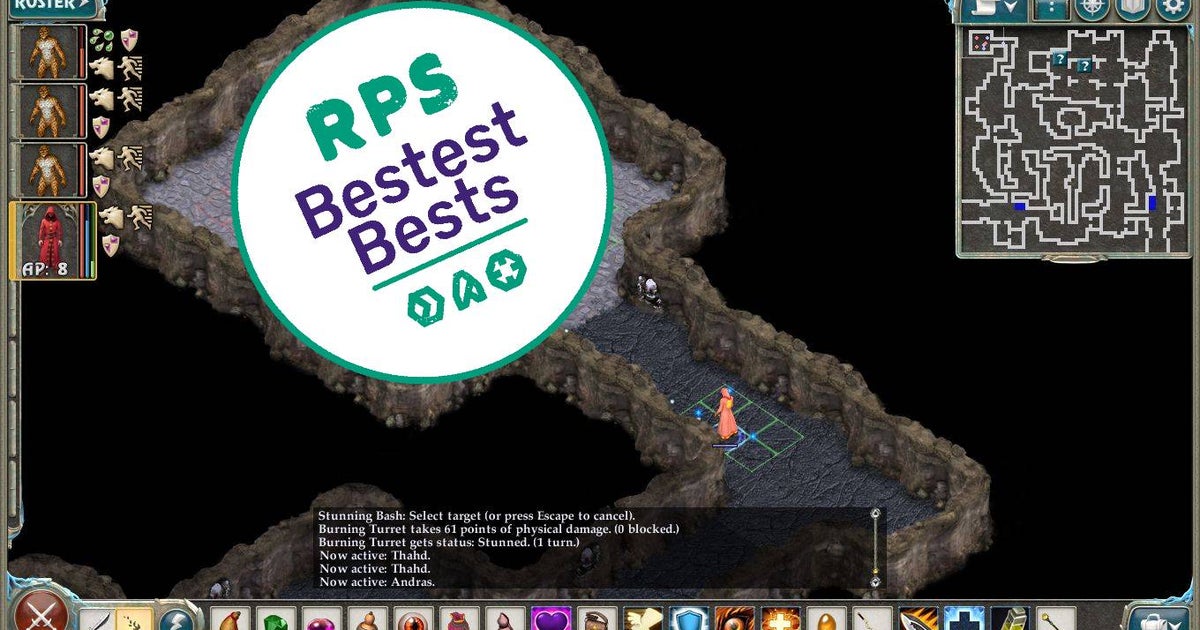Like the good works of Calvin Klein, these genes come pre-distressed. Geneforge 2 – Infestation is fresh from the rack, yet looks and functions like the CRPGs of the late 1990s. Where most isometric throwbacks these days offer a forced perspective over 3D scenes, Geneforge 2 is the real deal – its flat character sprites gliding across tiled backgrounds, with the elegant shuffle of Shōgun-era ladies-in-waiting.
This look is less a nostalgic affectation than it is simply practical. Geneforge 2, like all of Jeff Vogel’s games, was made in the spare bedroom of his Seattle home with the help of his wife, Mariann Krizsan – plus a handful of artists spread more broadly. It’s the latest in a long line of low-budget Spiderweb Software RPGs to achieve sprawling scale and reactivity by leaning on cost-effective and old-fashioned production values. Here there is no voice acting, nor any ambient noise that cannot be sourced from royalty-free soundbanks. In pastoral areas of the map, the impression of grazing livestock is conveyed entirely through a free sound effect called ‘Eating a rusk.wav’.
As a result, Geneforge 2 feels a bit cheap to begin with. In the moments where atmospheric bird squawks and howling winds give way, there can be little to sustain the illusion of a living world. But the gaps are soon filled by Vogel’s sharp prose and exquisite worldbuilding. The Geneforge universe – first conceived in the noughties, and fleshed out in Spiderweb’s current run of remakes – is one of the few truly original settings in the canon of western RPGs.
Its world of swords and sorcery is dominated by a sect called the Shapers, who have gained supremacy by turning pools of gooey essence into subservient lifeforms. Some of these genetically-modified creatures are monsters, meant for shoring up Shaper power and putting down insurrections. Others are Serviles, simple workers designed to find contentment in tilling fields and smashing rocks. Then there are the stranger beings, bred for highly specific purpose: the Servant Minds who manage mining operations from their trays, their stunted limbs rendering them little more than desktop computers; the sentient control panels trapped in granite, “alive and functional, though very, very bored”. The Shapers, having acquired their secrets through crude trial-and-error, now guard them closely and wield godlike social status among the common folk.
It’s a setup you might call science friction – oscillating between the highly advanced and the medieval, and lending itself to all sorts of social and moral quandaries. Should Serviles have rights? Try saying yes when your Shaper line manager is listening.
You enter this profound mess as an apprentice Shaper, lowly yet respected, sent to investigate a failed mountain colony and report back to your masters. Right from the off, you’re met with the consequences of genetic meddling gone wrong – rogue creations stumbling about the wilderness and wiry, weedlike trees cracking the foundations of dwellings. As Vogel pithily puts it, “The works of the Shapers consume the works of the Shapers”.
It’s Vogel’s voice that elevates all of Geneforge’s scenarios. He’s something of a shaper himself, bringing life to crude backdrops through text pop-ups that don’t beat around the twisted, misshapen bush yet contribute a sardonic twinkle to proceedings. “This tiny grove is no longer haunted,” he notes at the conclusion of a battle with some swampy ghosts. “Nothing helps exorcise an area of undead like a good, firm application of violence.” It’s the kind of individual flair that would only be diluted on a project with a larger writing team.



Geneforge 2 is explored in discrete chunks connected by an overworld map, in the style of the Infinity Engine games. As you trek high into inhospitable peaks, right at the limits of Shaper rule, you come across ever-more alarming breaches of the laws you know. The architects of these illegal activities look at you with a mixture of fear and eagerness – knowing you could bring an army of Shapers down on their heads, while hoping to persuade or manipulate you into their way of thinking. Deciding which factions to endorse or destroy – and when to show your hand by backing a side – ultimately becomes Geneforge 2’s endgame.
Obsidian’s Josh Sawyer has spoken before about his preference for gradual turns rather than dramatic twists – a dawning understanding, drawn from exploration and dialogue, that slowly shifts your perspective on the events unfolding around you. On that front, Geneforge 2 is a masterpiece. In no other RPG can you return to the starting town after 30 hours with a new and fundamentally different view of the place and its purpose.
Your investment in this conflict and intrigue is rewarded with the freedom to manoeuvre – dancing around problems rather than carving through them. Battles with groups you’d rather not face can be circumvented through dialogue or snuck around, provided you have the right skills. Many RPGs promise to support stealth and diplomacy, but few deliver so consistently as Geneforge 2. In that sense, it’s more comparable to Deus Ex: Human Revolution than its direct peers – at pains to provide you with alternate paths and opportunities to steal and sabotage. Geneforge even has its own take on the multitool – a tiny tentacled creature encased in metal, which can be jammed into locks and mechanisms. In this way, boss fights can be shortcircuited, and entire areas brought under your control through deadly electrical pylons.
As in the immersive sims of old, the cost of all this choice is a certain amount of depth – and you’ll occasionally ram your toes against the bottom of the pool. Stealth is no more advanced than in 1997’s Fallout, simply requiring you to keep your distance from hostile NPCs as you zigzag through a map. But the sheer speed of enemy movement lends these sequences an arcade-like tension, forcing you to adjust course quickly or trip into fights you’re not ready for. As in Baldur’s Gate 3, there’s also the option to trigger turn-based battle mode at will – allowing you to strategically steer your way around unaware patrols when the occasion demands it.
Combat at first feels basic, but reveals more and more nuance over time. In keeping with the godless experimentation of the Shapers, you’re able to summon and dismiss creations at will, constructing and disassembling units within seconds to suit your needs. The monsters have a pleasingly cheesy sensibility about them – like the fiery dinosaur Fyoras, who swarm like velociraptors, and the Thahds, who resemble ThunderCats yet punch like Victorian pugilists.

All can be upgraded, to be tougher or faster or covered in exploding boils that burst and wound your opponents. Some monsters are designed to detonate on death, and to be happy about it. But the more powerful your creations, the less control you wield over them. It’s a factor you’ll learn to take seriously once an injured Thahd has turned on you in a high stress situation, delivering a roundhouse punch to your delicately robed abdomen.
With experience, you learn to right-click your enemies to check their resistances before engaging – then build up a fire-spewing or poison-spitting roster accordingly. There’s a satisfaction to steamrolling an area or solving a situational problem by throwing the right beasts at it. In one instance, I sent in some stocky creations one-by-one to distract a golem while I ransacked the chests it was guarding – then left my monsters to their doom. It’s the kind of mercenary attitude you could never apply to an RPG with named companions, whose deaths typically prompt an instant reload. And it’s a form of utilitarianism that speaks to Geneforge’s core themes, in a way most combat systems don’t.
By the time you’ve begun to appreciate these nuances and story synergies, you’ll have long since seen past Geneforge 2’s visual shortcomings, the UI that fails to upscale with higher resolutions, and the goofy main menu with its frankly teenage animated cursor. Even if Baldur’s Gate 3 triggers a renaissance age for the western RPG, Spiderweb Software’s output will be unignorable so long as it delivers such a distinct flavour of wry, complex, and open ended roleplaying. Long may Vogel be in vogue.
This review is based on a retail build of the game provided by developers Spiderweb Software.


